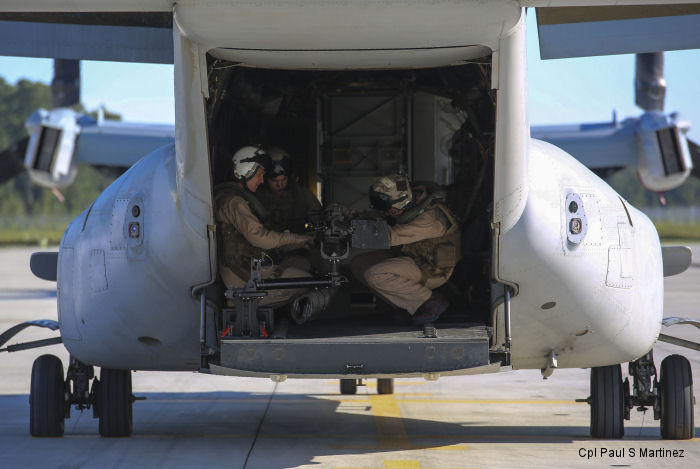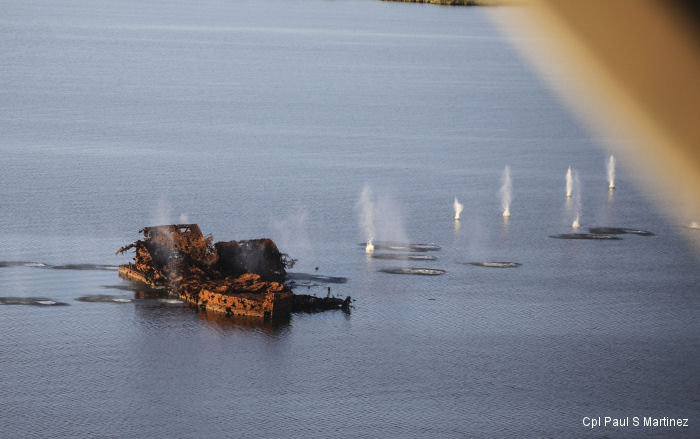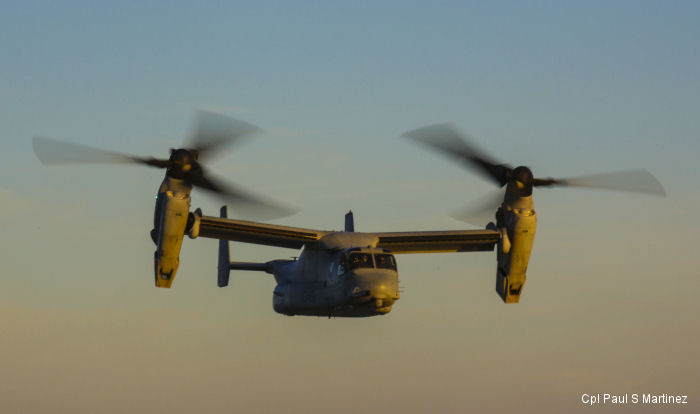US Marine Corps, September 17, 2015 - JACKSONVILLE, NC by Cpl Paul S Martinez - 2nd Marine Aircraft Wing Marines sent a hail of heavy rounds down onto the Piney Island bombing range Sept. 15, raking targets on land and in the bay in roaring demonstrations of gunnery prowess.
Marine Medium Tiltrotor Squadron 365 conducted the training to enhance the crew chief’s ability to be more proficient tail gunners, providing fire support for Marines on the ground from the advantageous sky.
Capt. Jacob R. Dyer, an MV-22B Osprey pilot with the squadron, explained how tail gunnery is a major aspect of a crew chief’s job. Their skill with the aircraft’s GAU-16 .50 caliber machine gun is vital to their performance in an operational environment.
“Our training and readiness standards list out everything we could be tasked with, and tail gunnery is one of the more important qualifications a crew chief can have,” Dyer said.
Overseeing the gunners on the rear of the aircraft were tail gunner instructors, one for each of the two aircraft. After assembling their weapon system, they made their way to Bombing Target 11, a training site east of Marine Corps Air Station Cherry Point, North Carolina. From there, the Marines rained down fire to engage targets in and out of the water that represented a convoy, barge and landing craft, at altitudes between 200 and 500 feet.
Firing the weapon system from a moving aircraft presents a challenge different from an engagement on the ground. There are several factors for the gunner to consider, such as the speed and direction of the aircraft and the wind resistance from a higher altitude.
“We have to look at it from a different perspective as aerial gunners,” said Staff Sgt. Anthony Knight, a crew chief and tail gunner instructor with the squadron. “We don’t have a range-finder or a sight. It’s more on seeing the target and how you have shot before and what you understand about the weapon system.”
The gunners overcame the scope of their engagement and left their targets riddled with holes, then with rounds spent, proceeded to oversee the lift back to the air station.
“It’s very important that crew chiefs are current and proficient in tail gunnery,” Dyer said. “Having qualified crew chiefs that have trained on the aircraft allow us to [efficiently] put a crew together to go on a mission.”
Marine Medium Tiltrotor Squadron 365 conducted the training to enhance the crew chief’s ability to be more proficient tail gunners, providing fire support for Marines on the ground from the advantageous sky.
Capt. Jacob R. Dyer, an MV-22B Osprey pilot with the squadron, explained how tail gunnery is a major aspect of a crew chief’s job. Their skill with the aircraft’s GAU-16 .50 caliber machine gun is vital to their performance in an operational environment.
“Our training and readiness standards list out everything we could be tasked with, and tail gunnery is one of the more important qualifications a crew chief can have,” Dyer said.
Overseeing the gunners on the rear of the aircraft were tail gunner instructors, one for each of the two aircraft. After assembling their weapon system, they made their way to Bombing Target 11, a training site east of Marine Corps Air Station Cherry Point, North Carolina. From there, the Marines rained down fire to engage targets in and out of the water that represented a convoy, barge and landing craft, at altitudes between 200 and 500 feet.
Firing the weapon system from a moving aircraft presents a challenge different from an engagement on the ground. There are several factors for the gunner to consider, such as the speed and direction of the aircraft and the wind resistance from a higher altitude.
“We have to look at it from a different perspective as aerial gunners,” said Staff Sgt. Anthony Knight, a crew chief and tail gunner instructor with the squadron. “We don’t have a range-finder or a sight. It’s more on seeing the target and how you have shot before and what you understand about the weapon system.”
The gunners overcame the scope of their engagement and left their targets riddled with holes, then with rounds spent, proceeded to oversee the lift back to the air station.
“It’s very important that crew chiefs are current and proficient in tail gunnery,” Dyer said. “Having qualified crew chiefs that have trained on the aircraft allow us to [efficiently] put a crew together to go on a mission.”
See also |
VMM-365
MV-22 in







